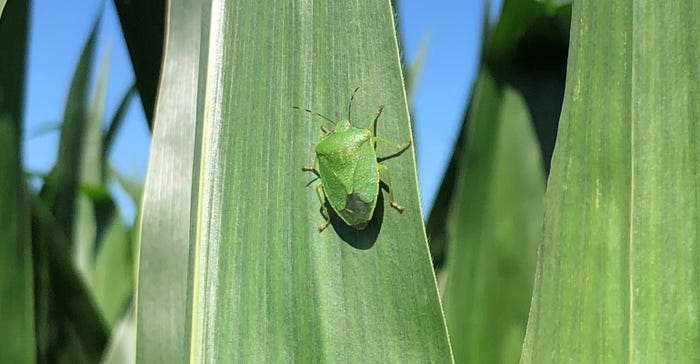
You may be more concerned about finding stinkbugs in soybeans. But you can find them in cornfields as well.
“We’ve seen signs of feeding by stinkbugs on leaves in some fields,” says Steve Gauck, Greensburg, Ind., an agronomy manager with Beck’s. “We usually are more concerned if we find brown marmorated stinkbugs in corn very early in the season, but you can find green stinkbugs, too.”
Later in the season, stinkbug feeding on leaves appears as oblong feeding marks, Gauck says. It’s unlikely that stinkbugs will do enough damage to impact a plant’s intake of sunlight for photosynthesis or affect yield. However, if you’re trying to determine what’s bugging corn — what’s important and what’s not likely to be a concern — it’s helpful to recognize the signs of stinkbug feeding later in the growing season. If you see these signs, determine if stinkbugs are still actively feeding within the crop canopy.
According to the Purdue University Corn & Soybean Field Guide, stinkbug adults are shield-shaped, resembling a pentagon. Typically, they’re broad and somewhat flat. As their names imply, brown stinkbugs are an earthy shade of brown; green stinkbugs are usually light green in color.

Reports from Purdue entomologist John Obermeyer, writing in the July 1 edition of the Purdue Pest & Crops Newsletter, indicate that if adult stinkbugs are feeding on corn leaves or in the whorl of mature plants, there will be no impact on yields.
Earlier feeding
When stinkbugs can cause an impact is if they feed on young corn seedlings during emergence earlier in the spring, right after planting, Obermeyer says. Feeding then can sometimes result in stunted, discolored plants. These plants typically remain short during the growing season, and don’t contribute to yield.
The situation is most likely to happen from feeding on seedlings by brown marmorated stinkbugs, Gauck says. Historically, plants damaged by stinkbug feeding early in the season are observed most often in fields with higher residue content.
Fields that were on the heavy side as far as moisture at planting and where the planting slot did not close properly are more likely to show signs of plants stung by stinkbugs. The term “stung” applies because of the way stinkbugs use their mouth parts to feed on plants.
Treating a cornfield with insecticide now because you see stinkbugs or stinkbug feeding on leaves would only be revenge, entomologists say. If plants within the field are stunted, it was due to feeding soon after corn emerged. Stinkbugs existing inside a cornfield late in the season won’t cause economic damage.
About the Author(s)
You May Also Like




